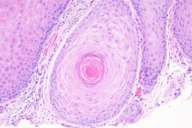Generalized eruptive keratoacanthomas
Published Web Location
https://doi.org/10.5070/D36b8870c5Main Content
Generalized eruptive keratoacanthomas
David H Chu MD PhD, Elizabeth K Hale MD, and Perry Robins MD
Dermatology Online Journal 9(4): 36
From the Ronald O Perelman Department of Dermatology, New York University
Abstract
We describe the case of a 71-year-old-woman with a 6-year history of generalized eruptive keratoacanthomas on the extremities. We review the diagnositic clinical and histologic features of the rare Grzybowski variant of generalized eruptive keratoacanthoma. The course of this disease is chronic and often demonstrates a poor response to therapy.
Clinical summary
History.—A 71-year-old-woman had a 6-year history of eruptions on the arms and legs. The patient initially presented with a 2-year history of crusted lesions on the arms. Over the course of the next 4 years, she developed intermittent crops of lesions; many of them on the arms and legs were excised using Mohs' micrographic surgery. There was no history of spontaneous involution of any lesions nor ocular or facial involvement. She denied a history of exposure to chemical carcinogens.
Past medical history includes hypertension, psoriasis of the nails, and breast cancer status-post lumpectomy. Her medications include tamoxifen and atenolol. She does not have a family history of skin cancer.
Physical examination.—Numerous, well-healed surgical scars were present on the arms and legs. Scattered, hyperkeratotic papules with central ulcers were noted on the right wrist and anterior aspects of the shins. No lymphadenopathy was appreciated.

|

|
| Figure 1 | Figure 2 |
|---|
Laboratory data.—None.
Histopathology.—There is a cluster of dilated, follicular infundibula with keratin plugs and a hyperplastic epidermis. There are scattered mitotic figures.
Diagnosis.— Generalized eruptive keratoacanthomas.
Comment
The original description of generalized eruptive keratoacanthomas (KAs) was made by Grzybowski in 1950 [1]. This condition is extremely rare, and fewer than thirty cases have been reported. It is characterized by multiple crops of lesions, at times with as many as thousands of follicular papules and ulcerated nodules that may, if left untreated, spontaneously involute and heal with atrophic scars. Extensive facial involvement can at times lead to ectropion and an infiltrated masked facies. Although the residual scars and number of lesions may result in appreciable morbidity, metastasis or visceral involvement has not been reported [1, 2].
Patients tend to develop lesions between the fifth and seventh decades of life, with an equal sex distribution. The condition does not show any pattern of inheritance. Although there is not documented linkage between this condition and systemic disease, individuals with this disorder have been reported with internal malignant conditions. General eruptive KAs are distinguished from multiple KAs of Ferguson-Smith, which is an autosomal dominant disorder that usually presents during adolescence, is characterized by sudden appearance of KAs, typically fewer in number than in the Grzybowski variant, and spontaneously involutes and reappears for many years.
Histologically, individual lesions of generalized eruptive KAs are indistinguishable from those of solitary KA [1, 2]. Features include a central crater filled with keratin, papillomatosis, acanthosis, and eosinophilic hyaline keratinocytes. There are many horn pearls, most of which show keratinization in their center. The base of a KA is well demarcated and regular, and often a dense inflammatory cell infiltrate of lymphocytes is present. The relation of KA to squamous cell carcinoma (SCC) remains controversial. Many of the histologic features of KA are shared with SCC, and, depending on the stage of the tumor, may be indistinguishable. The etiology of KAs is unknown. Some studies of solitary KAs have demonstrated the presence of human papillomavirus within the lesions. Association with human papillomavirus in multiple or eruptive KAs has not been observed [3]. A relationship between ultraviolet irradiation, chemical carcinogenic exposure, and interleukin-2 deficiency or other immune-system compromise has been postulated as predisposing factors for multiple KAs, although those associations have not been definitively proved.
Treatment options for extensive KAs are largely unsatisfactory, although oral retinoids are thought to be the most effective option. However, patients on such therapy often demonstrate recurrences and may develop debilitating scars. Other systemic therapy has included methotrexate, interferon-α, and ranitidine. For more localized disease, surgical excision, Mohs' micrographic surgery, topical treatment with retinoids or podophyllin, and intralesional injections of bleomycin, 5-fluorouracil, or glucocorticoids are treatment options with variable efficacy [4].
References
1. Schwartz RA, et al. Generalized eruptive keratoacanthoma of Grzybowski: Follow-up of the original description and 50-year retrospect. Dermatology 205:348, 2002.2. Consigli JE, et al. Generalized eruptive keratoacanthoma (Grzybowski variant). Br J Dermatol 142:800, 2000.
3. Haas N, et al. Nine-year follow-up of a case of Grzybowski type multiple keratoacanthomas and failure to demonstrate human papillomavirus. Br J Dermatol 2002; 147:793.
4. Sanders S, et al. Intralesional corticosteroid treatment of multiple eruptive keratoacanthomas: Case report and review of a controversial therapy. Dermatol Surg 28:954, 2002.
© 2003 Dermatology Online Journal

